 | « Back to article | Print this article |
The stage on which the Jammu and Kashmir flood disaster played out is littered with protagonists, most of whom did not receive the attention they deserve, says Ajai Shukla
If perspectives of this month's flood disaster in Jammu and Kashmir, especially the New Orleans-like inundation of Srinagar, were shaped only by national television, this would be a simple story of how the Indian Army again pulled the chestnuts out of the fire. Day after day, this monochromatic narrative played out with minor variations, like the suggestion that Kashmiris should thank the army for saving their undeserving hides.
The insensitivity even took the form of taunting questions to Kashmiris about whether they should now learn to love the army that they criticised so much. Had TV channel editors warned off their half-baked correspondents, the army might have benefited enormously from public gratitude for its selfless work.
Instead, there was seething anger on the streets of Srinagar at this crass and tactless milking of nationalism.

The stage on which this disaster played out is littered with protagonists, most of whom did not receive the attention they deserve. First amongst them is the aam Kashmiri. The national media failed dismally in highlighting the local response, and the rescue effort that locals mounted when their government proved unable to. While the state government has been rightly castigated for evaporating when it was most required, there has been insufficient examination of the pretenders -- the separatist leaders who usually waste no time shoving their way into the limelight.
The central government has reaped the benefits of the army's good work, but has questions to answer about why its other agencies failed to function, such as the National Disaster Management Agency. Let us publicly acknowledge the common Kashmiri --- an inappropriate term because Srinagar's inhabitants demonstrated in the face of calamity that they are uncommon folk.
From Day One of the crisis, even before the army could swing into action, students, mohalla leaders and common folk began moving the marooned to safer locations, using makeshift methods.

Initial army efforts benefited from these splendid youngsters, since government servants had simply abandoned their responsibilities. Then, with families separated and people missing, these techno-savvy youngsters used social media to bridge the communication gap. Others established relief camps to receive emergency supplies that began flowing into the valley as the country rallied behind Kashmir. The local media, even with its publication equipment knocked out by the flood, comprehensively outdid the national media. Taking quickly to social media, local reports provided the first insights into the bravery of locals.
Notwithstanding this grass-roots solidarity, the disaster revealed a traumatised, fractured and leaderless society. Of Kashmir's many internal fault lines, none has emerged as starkly as the abyss between the people and their leaders. This mirrors the street violence of 2008, 2009 and 2010, when leadership slipped into the hands of the people and previously unknown luminaries such as Masarat Alam. This month again, the Kashmiri leadership -- both elected and separatist -- vanished, reappearing much later as a speck in the rear-view mirror, scrambling to invent a rationale for itself.
Not even a disaster so immense should sweep away an entire government structure. If, as Chief Minister Omar Abdullah dramatically declares, Kashmir's police, civil servants and even ministers were themselves struggling to survive, why did they not reappear later, in whatever battered form, for rescue work?
When students and local community members could organise rescue work, what reason was there for governance to evaporate?

The bleak conclusion is that the J&K government has become a securitised structure, focused only on the physical protection of its leaders and functionaries. Will the J&K government call its absconding functionaries to account? Unlikely, given that the absentees include top bureaucrats and ministers. In another environment, fundamentalist, even jihadi elements might have garnered credibility by coming forward when government leadership collapses. This happened during the 2010 floods in Pakistan, when Jamat ud Dawa (the Lashkar-e-Tayiba front) was prominent in organising rescue and relief, just as it had done after the 2005 earthquake in Kashmir. 
Fortunately, the separatist leadership in Kashmir is less dynamic. Syed Ali Shah Geelani, who could have opportunistically gained brownie points, only discredited himself by accusing the army of "staging rescues" for TV cameras. Mr Geelani grossly underestimates the Kashmiri people. It is hard to dispute that the army has emerged from this disaster with its image enhanced. Yet it is the nature of day-to-day politics in Kashmir that this is only a transient gain. A single fake encounter, a single allegation of rape or molestation and the public dialogue will revert to the injustice of the Armed Forces Special Powers Act and the alleged brutality of "India's army of occupation". New Delhi must realise that the military's good work in the floods is a mere opportunity for a political outreach to Kashmir. If the moment is not grasped, it will quickly pass. 
The most impressive dimension of the army's rescue work was not the 226,000 people rescued; the infant handed out swaddled in a blanket; the grandmother hauled out of swirling waters; or the chopper landing on the roof of a house to convey the frantic inhabitants to safety. The army does those things all year round. Instead, an unusually impressive performance has come from the army's media organisation, the Army Liaison Cell.
Under an imaginative commander, Lieutenant General Shokin Chauhan, the ALC transformed its Facebook page and Twitter feed into an information exchange, in which distressed enquiries from across the country were forwarded through a closed WhatsApp group to Srinagar, providing inputs into decisions about where to send rescue parties. Similarly, details of people rescued flowed back from Srinagar, with the ALC disseminating the good news to the world.
The army's long-standing weakness has been its public interface. This could be changing.
